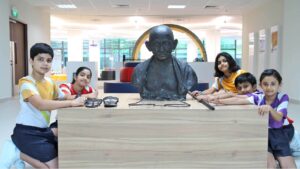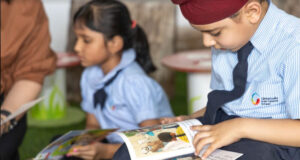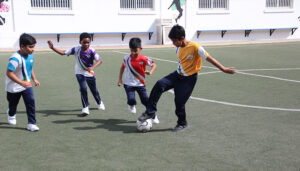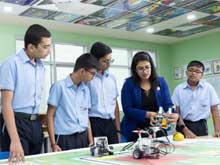In the vibrant city of Abu Dhabi, where modernity meets cultural values, parents find themselves standing at a crossroads with endless questions in their mind regarding the educational program provided at the school here.
It’s a universal quest that relates to countless parents worldwide – how do we strike the perfect balance between the pursuit of knowledge and character development? Focusing on providing children with an education that not only excels in academics but also nurtures them. As the educational landscape continues to evolve, let’s understand what’s in store.
Have these thoughts come into your mind before?
● “Is Traditional education alone enough to prepare my child for the challenges of the future?”
● “If well-rounded education can open doors to a brighter and more fulfilling future for my child?”
This article is for you, where you will understand the innovative approaches of International Schools and their education system that are shaping the minds of tomorrow in Abu Dhabi.
Understand the Concept of A Holistic Approach to Education
In the enchanting journey of education, a fascinating concept has taken center stage – the holistic approach. But what exactly is this magical method that promises to transform our children into well-rounded individuals?
Let us understand in detail the core principles, and the impact it has on our young learners.
A child’s education is like a puzzle, where each piece represents a unique aspect of their growth, from academic to emotional intelligence, creativity to physical well-being. This concept where every aspect is focused is called the “Whole Child” approach to education. Holistic learning
means educating young minds far beyond textbooks and standardized tests.
What is the Whole Child Approach to Education?
At its core, the Whole Child approach acknowledges that children are not just curious brains waiting to be filled with interesting facts but are complex beings with various needs and potential. It strives to nurture every aspect of a child’s development, ensuring they are prepared as well-rounded individuals who can confidently thrive in a competitive world and face the complexities of life.
Holistic Development for Students is like music where every note matters. It’s an approach that goes beyond traditional learning and grades, focusing on the development of the whole child – mind, body, and spirit.
It’s not just overwhelming young minds with facts; it’s about nurturing their curiosity, creativity, and character.
It encourages children to explore the world around them, asking questions like:
● How does nature inspire our learning?
● What can we learn from different cultures and traditions?
H3: The Five Pillars of the Whole Child Holistic Approach to Education:
● Academic Excellence: Academic knowledge matters, but the Whole Child approach seeks to make learning an engaging, and meaningful experience. The priority focus is definitely on what they are learning but more on the approach to how they are learning.
● Emotional and Mental Health: As per study, a child’s emotional well-being greatly influences their academic performance and whole life experiences. When children feel valued, emotionally supported and safe, their learning potential increases tremendously which is reflected in their academic achievements and personal life.
● Physical Health: Physical fitness is an integral part of the Whole Child approach as a healthy body is a healthy mind. Physical education, nutrition, and regular exercise are taught to students, fostering well-rounded development.
● Cultural Awareness: In today’s world of globalization, it’s necessary for children to understand and respect different cultures and other’s perspectives. This aspect of the whole child develops tolerance, patience, empathy, and open-mindedness.
● Critical Thinking and Creativity: Thinking logically and coming up with new ideas is an important building block of problem-solving abilities and innovation. Development of these thinking skills prepares children for a future where they are prepared to face any challenges life throws at them.
Facts:-
● According to the American Institutes for Research, schools implementing the Whole Child approach reported improved attendance, reduced behavioral issues, and better academic performance.
● A study published regarding Public Health says that physical activity not only improves health but also boosts cognitive function and academic achievement.
● UNESCO highlights the importance of cultural education, leading to peace, and fostering mutual understanding among diverse groups.
● Did you know? A holistic approach to education has a great influence in reducing stress levels among students, leading to improved overall well-being.
H2: Challenges Faced by the Parents in Academic Session
The academic season often feels like a tempestuous sea, with waves of challenges crashing against the shore. But what are the challenges, and how can parents steer their ships through these turbulent waters?
Let’s understand in detail.
Challenge 1: Homework Overload
Homework can sometimes feel like a never-ending mountain, leaving parents and kids stressed and overwhelmed. Research indicates that homework overload can lead to stress in children and parents alike.
Solutions:-
Schools should set clear guidelines for reasonable homework loads and ensure assignments are meaningful. Parents can create a quiet and organized space for homework and establish a regular routine to manage homework effectively.
Challenge 2: Time Management Troubles
Juggling work, household chores, and extracurricular activities can leave little time for academics.
Solutions:-
Effective time management can reduce stress and improve overall family well-being.
Parents can teach time management skills, set priorities, and create a calendar. Schools can consider flexible scheduling for parent-teacher meetings.
Challenge 3: Peer Pressure and Expectations
Children often feel pressure to excel academically, and parents may feel societal expectations weighing them down.
Solutions:-
Studies show that parental involvement in a child’s education can positively impact their academic success. Parents can encourage a growth mindset, emphasizing effort over grades. Schools can promote a culture of diversity and respect for different learning paces.
Challenge 4: Technology and Screen Time
In the digital age, screens are ubiquitous. Managing screen time and ensuring technology is used for learning rather than distraction can be a constant battle. Excessive screen time has been linked to reduced academic performance in children.
Solutions:-
Parents can set screen time limits and provide tech-free study zones. Schools can educate students about the importance of responsible screen use.
Challenge 5: Teacher-Parent Communication
Transparency and communication are necessary in teachers and parents for a child’s academic progress. But sometimes, bridging this gap can be challenging.
Solutions:-
Research suggests that regular parent-teacher communication can lead to improved student outcomes.Parents can maintain open communication with teachers through regular meetings and emails. Schools can provide clear channels for communication, such as newsletters and online portals.
Challenge 6: Individual Learning Needs
Every child learns differently, and some may need extra support.
Solutions:-
Parents can communicate with teachers to create customized learning plans for their children. Schools on the other hand, can offer additional resources and support, such as tutoring or special education services.
In the journey of parenthood, these challenges can be tremendous tasks but by understanding these challenges and implementing logical solutions, parents can help their children in their academic year with confidence and enthusiasm.
Holistic Education Options for Parents in Abu Dhabi
The focus of the holistic curriculum is on developing a child’s overall development; intellectual, emotional, social, and physical well-being. Here are a few Education options that develop your child holistically which you can consider..
1. International Baccalaureate: There are several schools that offer IB programs which focus on personal development, creativity, and community involvement. IB programs are designed to make students into all-rounders.
2. Global Montessori Plus Program: GMP focuses on students’ overall growth with its innovative and unique academic training. The award-winning programme is infused with the phenomenal GIIS pedagogy that develops multiple intelligences in students through futuristic learning techniques.
GMP Plus programme offers robust 5 pillars that teach extraordinary skills, character development, physical growth, and universal values and prepare the students to face the future challenges with modern learning technologies.
● ExcelerateProgramme
● Multi-faceted Learning
● iPlayProgramme
● iCareProgramme
● Future Ready Program
3. STEAM Education: STEAM (Science, Technology, Engineering, Arts, and Mathematics) education is another amazing program which combines traditional subjects with creative and problem-solving skills encouraging children to think critically, innovate, and explore various areas of knowledge.
4.The holistic learning approach isn’t confined to classrooms, it incorporates outdoor and experiential learning into their programs. This means children get to learn through real-world experiences, such as field trips, nature visits, and practical projects, which can help them connect with the world around them.
5. Social and Emotional Learning (SEL): SEL programs teach children life skills such as empathy, self-awareness, and conflict resolution which develops emotional and social development, equipping them to handle life’s challenges.
Note:- When seeking School admission and holistic education options in Abu Dhabi check if the school offers diverse learning experiences, prioritizes personal development, and goes beyond traditional academics.
Fostering Holistic Development: Strategies and Approaches
Fostering holistic development involves using various strategies and approaches that consider all aspects of a child’s growth.
Here are some of the strategies:-
● Customize Learning: One size doesn’t fit all, as every child has unique abilities. Individualized learning helps in customizing a program to a child’s specific needs and interests helping them engage better with the material and learn at their own pace.
● Hands-On Learning: Children learn by doing things practically which makes learning more fun and memorable. Hands-on learning activities should be involved where they can actively participate in experiments, art projects, or building things.
● Integrated Curriculum: Instead of teaching subjects in isolation, an integrated curriculum should be connected with different topics as it will help in the memorization of certain concepts. For example, if children are learning about ancient Egypt, teachers should involve some part of history, geography and art together which shows students how knowledge is interconnected.
● Critical Thinking and Problem Solving: Providing students with questions or equations to think critically helps them analyze information, ask questions, and solve problems. This skill prepares them for future life.
● Social and Emotional Learning (SEL): SEL programs should be integrated so that children will get to learn more about themselves, their emotions, empathy, and social skills. It will help to understand and manage their feelings, communicate effectively, and build healthy relationships.
● Outdoor and Nature-Based Learning: Spending time outside the classroom, visiting places, carrying out outdoor activities or learning about nature will help students to take a break from regular learning. It will also help children to appreciate the environment, stay active, and develop curiosity about the world around them.
● Arts and Creativity: Creativity is part of holistic development. Encouraging kids to explore the arts, music, painting, or drama, expressing things in various ways or creative activities will allow them to boost their imagination, and build confidence.
● Physical Activity: Physical fitness is again a part of holistic development. Teachers should involve regular exercises, or certain physical activities to keep children healthy and boost their mood and focus.
● Character Education: Schools should focus on character development programs or activities as it will help students to become honest, respect others, and be responsible. It will help children to develop good character traits and become responsible citizens.
● Community Service: Schools should focus on engaging children in community service or volunteering activities as it will teach them about giving back to society and making a positive impact instilling a sense of responsibility and empathy.
● Parent’s Positive Influence: Parents are a child’s first teachers, so they should make sure that they have a positive impact on their child. In order to develop a curiosity in children to explore various things so that they can follow them, Parents’ should themselves have an active focus on all these important aspects of life. Parents should establish a strong support system which is essential for a child’s growth and development.
● Reflection and Self-Assessment: Both Teachers and parents should make sure to have sessions where children are asked to reflect on their experiences and assess their progress. They should be taught to take learning from both successes and setbacks helping them to develop a growth mindset.
By using these strategies and approaches, educators and parents can work together to nurture a child’s intellectual, emotional, social, and physical development.
The Teacher’s Role in Facilitating Holistic Child Development
Teachers play multiple roles; educators, facilitators, role models, and mentors in a child’s development, especially in a CBSE international school. They impart knowledge and essential skills, laying a strong foundation in their academic journey. Beyond this, they foster an environment where children explore, question, and discuss, and learn independently through engaging activities. They showcase qualities like kindness, respect, and curiosity, which often inspire students to emulate these positive behaviors. They guide students, offer emotional support, and help in achieving their goals.
Let’s understand in detail how they facilitate Holistic Child Development
● Nurturing Environment: Teachers create an environment where children feel safe, respected and valued which helps them to open up and learn effectively.
● Individualized Learning: Teachers know that every child is unique so they adapt their teaching methods to cater to each student’s needs, helping them to tackle their strengths and weaknesses. They also provide enough time for children to learn at their own pace.
● Fostering Curiosity: Teachers encourage students to ask questions, suggest, discuss and be curious about what they are learning. This helps students to take part in various subjects and helps kids explore their interests.
● Teaching Critical Thinking: Teachers while providing answers; encourage students
to think critically, ask questions, and analyze information which helps them to solve problems and make informed decisions.
● Promoting Social Skills: Teachers facilitate activities and projects that lead to interactions among students helping students to develop social skills like empathy, cooperation and conflict resolution.
● Emotional Support: When a child is upset or struggling, a teacher provides guidance, listens to their feelings and helps them in managing their emotions. They provide a supportive environment where children can openly discuss their feelings, helping them to be themselves.
● Varied Teaching Methods: Teachers use different techniques like hands-on activities, games, and technology while imparting knowledge to students which makes learning engaging and fun.
● Setting Goals: Teachers help students set academic and personal goals which help students track their progress. They celebrate students’ achievements, which boosts self-esteem and motivation.
● Encouraging Creativity: Teachers organize various creativity activities helping students to have a break from their learning. This helps students to engage in art, music, writing, or other activities helping them to understand their passion.
● Physical Education: Teachers incorporate various physical activities into the curriculum which keeps students active and healthy.
● Character Education: Teachers model good behavior like kindness, respect, and honesty and make them understand the importance of these values in daily life.
● Communication and Collaboration with Parents: Teachers maintain open communication with parents which helps them share progress reports, discuss concerns, and collaborate in various ways to address challenges.
● Assessment: Teachers assess each student, track their progress and provide available feedback which helps students excel in the areas where they are weak. Their support and additional assistance, ensure students have a well-rounded educational experience.
In essence, a teacher’s role in holistic child development is like a guiding light, helping children become well-rounded individuals ready to face the world.
Enhancing Holistic Education: Parental Involvement and Support at GIIS International School
GIIS International School knows the importance of Parental Involvement and Support. They know when parents are involved and supportive, it makes the education better in every way. So, they have taken many major steps to make sure parents and teachers work together closely.
Here are various ways GIIS International School strengthens the partnership between parents and educators to create a more comprehensive and well-rounded educational environment for students.
● Parent-Teacher Conferences: GIIS organizes regular meetings where parents can sit down with teachers to discuss their child’s progress, strengths, and areas needing improvement.
● Open Houses: The School holds open house events where parents can meet teachers, and see their child’s classroom and projects.
● Regular Communication: Open lines of communication are maintained through emails, and online platforms, ensuring parents are informed about school activities and updates.
● Workshops and Seminars: The school conducts workshops and seminars for parents on various educational topics, helping them understand the curriculum better which can support their child’s learning.
● Parent-Teacher Associations (PTA): GIIS have a PTA that allows parents to actively participate in school decision-making, fundraising, and organizing events.
● Homework and Assignment Updates: The school has an online platform where parents are notified with information on homework and assignments, making it easier for parents to assist their children with their studies.
● Parental Involvement in Extracurriculars: Schools organize various clubs, sports, volunteering and extracurricular activities, encouraging parents to participate and fostering a sense of teamwork and involvement in their child’s education.
● Digital Learning Platforms: Schools provide online platforms where parents access resources, track a child’s academic progress, and have communication with teachers.
● Parent Education Resources: These schools provide parents with educational resources and materials to support their child’s learning at home.They suggest activities that parents can do at home to support what the child is learning in school.
● Counseling and Support Services: GIIS offers counseling and support services for parents who may need assistance on various aspects of parenting or education.
Conclusion
In this vibrant oasis of possibilities, Abu Dhabi offers a rich bouquet of holistic educational choices, each one a promise to nurture not just the intellect, but the heart and soul of our future generations.
We welcome your insights on fostering creativity and critical thinking within school environments, as well as your perspective on the key elements of the holistic approach that you believe are paramount in equipping children for success in the 21st century. Your innovative ideas are invaluable to us, and we eagerly anticipate the opportunity to incorporate them into our efforts.
Frequently Asked Questions
What is the Holistic Education of Children’s Learning?
It focuses on nurturing all aspects of a child’s development from intellectual to emotional, from social to physical well-being, helping students to be well-rounded individuals.
What are 5 Examples of Holistic Development?
Examples of holistic development include cognitive growth through academic learning, emotional development by fostering self-awareness and empathy, social skills enhancement, physical fitness, and the cultivation of creativity and critical thinking.
What are the Objectives of Holistic Education?
The objective is to develop individuals who are academically proficient, emotionally intelligent, socially adept, and physically fit thereby preparing them for success in various facets of life.
How do you Ensure the Holistic Development of Students?
Holistic development in students can be ensured through a combination of approaches, including individualized learning, character education, extracurricular activities, social and emotional learning (SEL) programs, and strong parent-teacher partnerships.
What are the Three Developmental Goals for Holistic Development?
The 3 key developmental goals are academic excellence, emotional and social well-being, and the development of critical thinking and problem-solving skills, which is the need of students to thrive in the 21st century.





























